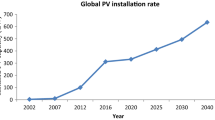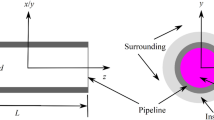Abstract
This paper presents an innovative method devised to study some of the harmful effects of moisture on power transformers, considering the possible formation of bubbles and free water. Its novelty stems from the fact that it comprises: (a) a rating system from “A” to “E” and their respective recommended actions and (b) an analysis that involves varying the different levels of electrical loads applied to the equipment. The importance of this work is confirmed when power transformers are exposed to unfavorable conditions that can critically affect their insulation. To this end, a tool to study moisture was developed, which uses the finite difference method, based not only on the experience of experts/analysts but also on existing studies in the area and on the analysis of a database of actual field tests. The contribution of this work is an efficient method, implemented via a computational algorithm, which provides a technique for the real-time or offline rating of power transformers, helping maintenance teams to diagnose problems and decide whether or not to repair the equipment. The tool provided the satisfactory results, which are presented in a case study of a real transformer operating at the local electric utility company. These results were obtained by applying different levels of electrical loads, for which thermal simulations were performed.












Similar content being viewed by others
References
ABNT. (2006). Brazilian Association of Technical Standards NBR 10710:2006—Electrical insulating liquids—Determination off water content. Rio de Janeiro, Brazil.
ABNT. (2012). Brazilian Association of Technical Standards NBR 7274:2012—Interpretation of gas analysis of in-service transformers. Rio de Janeiro, Brazil.
CIGRÈ WGA2.180. (2003). Life management techniques for power transformers, CIGRÈ Publication WG A2.18. Paris, France.
CIGRÈ WG A2.30. (2008). Moisture equilibrium and moisture migration within transformer insulation systems, CIGRÈ Publication WG A2.30. Paris, France.
Coker, A. (2007). Ludwig’s applied process design for chemical and petrochemical plants (4th ed., Vol. 1). Houston: Gulf Professional Publishing.
Du, Y., Zahn, M., Lesieutre, B., Mamishev, A., & Lindgren, S. (1999). Moisture equilibrium in transformer paper-oil systems. IEEE Electrical Insulation Magazine, 11–20.
Gao, M., Zhang, Q., Ding, Y., Wang, T., Ni, H., & Yuan, W. (2017a). Investigation on bubbling phenomenon in oil–paper insulation. IEEE Transactions on Dielectrics and Electrical Insulation, 24(4), 2362–2370.
Gao, M., Zhang, Q., Ni, H., Ding, Y., & Yuan, W. (2017b). Study on gas bubble formation in single-layer paper insulation. In 2017 1st International conference on electrical materials and power equipment (ICEMPE), Xi’an, China.
Hill, J., Wang, Z., Liu, Q., Krause, C., & Walker, D. (2018). Review of experiments investigating transformer insulation condition on bubble inception temperature. In 12th IEEE international conference on the properties and applications of dielectric materials (ICPADM), Xi’an, China.
International Electrotechnical Commission—IEC. (2018). International Standard IEC 60076-7—Loading guide for oil-immersed power transformers. Geneva, Switzerland
Koch, M., & Tenbohlen, S. (2011). Evolution of bubbles in oil–paper insulation influenced by material quality and ageing. IET Eletric Power Applications, 5(1), 168–174.
Marques, A., Sousa, F., Brito, L., Ribeiro, C., Azevedo, C., & Santos, J. (2015). A mathematical contribution to the analysis of moisture migration in power transformer oil–paper insulation systems. In 2015 IEEE 10th international symposium on diagnostics for electrical machines, power electronics and drives (SDEMPED), Guarda, Portugal.
Morais, D. R., Bencz, E., & Rolim, J. G. (2014). Condition assessment of power transformers through the integration of historical and on-line data in a multi-agent system. Journal of Control, Automation and Electrical Systems, 25, 93.
Oommen, T. V., & Lindgren, S. R. (2001). Bubble evolution from transformer overload. In 2001 IEEE/PES transmission and distribution conference and exposition, Atlanta, United States of America.
Przybylek, P. (2010). The influence of cellulose insulation aging degree on its water sorption properties and bubble evolution. IEEE Transactions of Dieletrics and Electric Insulation, 17(3), 906–912.
Wang, H., Yin, J., Cheng, L., Liao, R., & Yang, L. (2019). A non-destructive testing method for moisture content of oil–paper insulation based on terahertz dielectric response. 2019 IEEE conference on electrical insulation and dielectric phenomena (CEIDP), Richland, WA, USA, pp. 741–744.
Author information
Authors and Affiliations
Corresponding author
Additional information
Publisher's Note
Springer Nature remains neutral with regard to jurisdictional claims in published maps and institutional affiliations.
Rights and permissions
About this article
Cite this article
de Carvalho Sousa, F.R., de Jesus Ribeiro, C., Pereira Marques, A. et al. Method for Rating and Analyzing the Combined Effects of Moisture and Temperature on the Oil–Paper Insulation System of Power Transformers by Means of Load Variations. J Control Autom Electr Syst 31, 1309–1321 (2020). https://doi.org/10.1007/s40313-020-00607-7
Received:
Revised:
Accepted:
Published:
Issue Date:
DOI: https://doi.org/10.1007/s40313-020-00607-7




